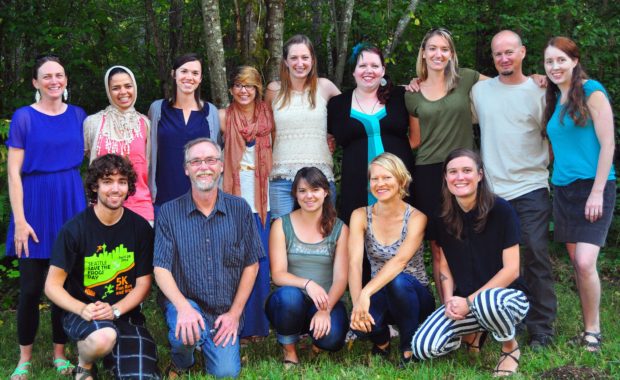
SPP Graduate Research Assistant Brittany Gallagher helps an Oregon spotted frog take its first leap into the wild. Photo by Matthew Williams of the New York Times.
By Brittany Gallagher, External Affairs Manager, The Nature Conservancy
When I was looking into graduate schools, I searched for an environmental studies program in which social justice was an integral–and integrated–part. As a Returned Peace Corps Volunteer, I was sensitive to inequitable global environmental policy and its detrimental effects to community economic development on both a global and a personal scale. I was interested to fill in my gaps in experience and knowledge with a more thorough understanding of environmental and social justice at home in the US. Though Evergreen’s Graduate Program on the Environment seemed like a good fit, it was the existence of the “Sustainable Prisons Project” (as it was called at the time) on campus that sealed the deal for me.
Thanks to a generous Sara Bilezikian Memorial Fellowship supporting students working for justice in the environmental arena, I was able to begin my time as an MES student even as I moved to Olympia from out of state. I had also emailed SPP staff before I arrived, applying for a job that didn’t exist yet, but thanks to some persistence and a fortuitously timed grant, I became the Education & Evaluations Coordinator for SPP. Alongside my studies, I spent my two years at Evergreen running a pair of lecture series at Stafford Creek Corrections Center and Washington Corrections Center for Women. I also worked to evaluate SPP’s various ecological conservation programs. Out of this effort grew my Master’s thesis, examining the social and human effects of participating in SPP’s conservation programs on the inmate technicians who cared for frogs, dogs, butterflies, and prairie plants.
In the years since graduation, I have mentioned SPP in every job interview I’ve had, as well as dropping it into casual conversation on dates, and with strangers sitting next to me on airplanes. We may forget it on our super-green Evergreen campus in the “upper-left” USA, but SPP’s model is fascinating to people. Working with state agencies, prison staff and inmates, academics, and volunteers from the community gave me the skills needed to engage across cultures and value sets to achieve a common purpose. These experiences translate, and they have continued to pay off as I’ve gone on to work in international development and education, and in my current position as External Affairs Manager for The Nature Conservancy in Washington. Now more than ever, cooperation and collaboration with perhaps-unlikely partners for the good of people and the planet is the way to go, and I am proud to have been a piece of SPP’s important and continuing great work.














 Graduation brings an end to student-staff employment. Each coordinator trains their successor, which is as much about introducing them to the culture and ways of thinking as it is about program policy and protocols. Each turnover is bittersweet. We have to say good-bye to someone we have relied on and invested in, and it is painful to see them go.! At the same time, we get to welcome someone new, and their fresh perspectives helps SPP to continually improve; we can’t get stale! Also, there is the satisfaction of seeing SPP alumni go on to new and valuable endeavors, and we take pride in supporting their ongoing careers and aspirations.
Graduation brings an end to student-staff employment. Each coordinator trains their successor, which is as much about introducing them to the culture and ways of thinking as it is about program policy and protocols. Each turnover is bittersweet. We have to say good-bye to someone we have relied on and invested in, and it is painful to see them go.! At the same time, we get to welcome someone new, and their fresh perspectives helps SPP to continually improve; we can’t get stale! Also, there is the satisfaction of seeing SPP alumni go on to new and valuable endeavors, and we take pride in supporting their ongoing careers and aspirations.







 by Kristina Faires, SPP Program Enhancement Coordinator
by Kristina Faires, SPP Program Enhancement Coordinator







